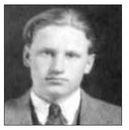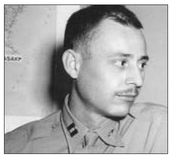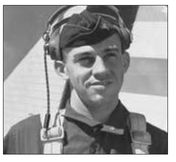War Stories II (17 page)
Authors: Oliver L. North

But if Doolittle had any doubts, he did not show it.
Corporal Jake DeShazer, from Salem, Oregon, was a cook for a sheep-herding camp before he joined the Army Air Corps in 1940 at the age of twenty-seven. He remembers being on KP duty when Pearl Harbor was bombed and thinking to himself, “Japan is really going to get it for this.” DeShazer recalls standing alone on the
Hornet
's flight deck, thinking, “I wonder how many more days I am going to spend in this world. Maybe I wasn't so fortunate after all to get to go on this trip.”
Hornet
's flight deck, thinking, “I wonder how many more days I am going to spend in this world. Maybe I wasn't so fortunate after all to get to go on this trip.”
On 16 April, in heavy seas, the sailors and Army airmen aboard the
Hornet
moved the B-25s to a parking area at the rear of the flight deck, where they would be ready to take off. The following day the weather deteriorated
further. Halsey and Doolittle, concerned about the ability of the sailors and airmen to work on the open flight deck, ordered the planes fueled and bombs loaded, even though the task force didn't plan to be at the launch point until late on 19 April.
Hornet
moved the B-25s to a parking area at the rear of the flight deck, where they would be ready to take off. The following day the weather deteriorated
further. Halsey and Doolittle, concerned about the ability of the sailors and airmen to work on the open flight deck, ordered the planes fueled and bombs loaded, even though the task force didn't plan to be at the launch point until late on 19 April.
By darkness on 17 April, the airmen and deck crews were exhausted, but Halsey and Doolittle had done all they could to prepare. Now if they could just avoid the enemy picket ships and patrol craft, the
Hornet
might be able to get within 400 miles of Japanâand that edge might give the B-25s and their crews a chance of surviving the mission. But it wasn't to be.
Hornet
might be able to get within 400 miles of Japanâand that edge might give the B-25s and their crews a chance of surviving the mission. But it wasn't to be.
 USS HORNET
USS HORNETTASK FORCE 16.2
650 MILES OFF JAPANESE COAST
18 APRIL 1942
650 MILES OFF JAPANESE COAST
18 APRIL 1942
In the predawn morning hours of 18 April, a radar operator on the
Enterprise
reported a “surface contact”âa shipâabout ten miles from the carrier. Though the
Enterprise
was still more than 650 miles from Japan, Halsey ordered the entire task force to change direction to keep from being spotted by what had to be a Japanese ship. Then, at 0600, an American scout plane scouring the waters ahead of the American ships saw a Japanese patrol boat.
Enterprise
reported a “surface contact”âa shipâabout ten miles from the carrier. Though the
Enterprise
was still more than 650 miles from Japan, Halsey ordered the entire task force to change direction to keep from being spotted by what had to be a Japanese ship. Then, at 0600, an American scout plane scouring the waters ahead of the American ships saw a Japanese patrol boat.
Hoping to sink the vessel before it could notify Japan of their presence, Halsey's cruiser, the USS
Nashville,
engaged with five-inch gunfire at 0738, and immediately afterward dive-bombers from the
Enterprise
attacked the picket ship. The
Nitto Maru
, designated as Japanese Naval Patrol Boat No. 23, sank in minutes. But not before the crew radioed Imperial Fleet HQ at Kure that three American aircraft carriers were headed for Japan.
Nashville,
engaged with five-inch gunfire at 0738, and immediately afterward dive-bombers from the
Enterprise
attacked the picket ship. The
Nitto Maru
, designated as Japanese Naval Patrol Boat No. 23, sank in minutes. But not before the crew radioed Imperial Fleet HQ at Kure that three American aircraft carriers were headed for Japan.
Aboard the
Enterprise
, Navy code-breakers intercepted the
Nitto Maru
's radio traffic, and though the
Nitto Maru
incorrectly warned that there were three American carriers, it still meant that, despite the weather, the task force was now in great jeopardy. So, too, was Doolittle's attack plan.
Enterprise
, Navy code-breakers intercepted the
Nitto Maru
's radio traffic, and though the
Nitto Maru
incorrectly warned that there were three American carriers, it still meant that, despite the weather, the task force was now in great jeopardy. So, too, was Doolittle's attack plan.
The
Hornet
, with the sixteen B-25s aboard, was still hundreds of miles away from its intended launch destination, and hundreds of miles more
from the targets in Japan. Halsey had planned to steam west another thirty-two hours before launching the bombers, so that they would arrive over their targets on the night of 19 Aprilâand be able to find their landing fields in China on the next morning.
Hornet
, with the sixteen B-25s aboard, was still hundreds of miles away from its intended launch destination, and hundreds of miles more
from the targets in Japan. Halsey had planned to steam west another thirty-two hours before launching the bombers, so that they would arrive over their targets on the night of 19 Aprilâand be able to find their landing fields in China on the next morning.
Admiral Halsey and Doolittle now had to make a serious decision, and it had to be made quickly. The carriers couldn't proceed closer to the intended launch point, loath to engage an overwhelming Japanese naval force or provoke an attack by land-based bombers. But could the B-25s still make it to their targetsâand then on to safety in Chinaâif they launched now? If not, their only alternative was to abandon the mission. By signal light, from his flagship to the
Hornet,
Halsey presented the options to Doolittle.
Hornet,
Halsey presented the options to Doolittle.
The Army flight leader wasted no time in making a decision. Even though they were still nearly 700 miles from Tokyo, with almost no chance of reaching the recovery airfields in China after the bombing raid, Doolittle signaled back, “Let's go now.”
Halsey ordered the task force to turn into the wind and gave the order to launch the aircraft. The admiral ended his message with, “Good luck, and God bless you.”
Aboard the
Hornet
, Army airmen and sailors sprang into action as loudspeakers blared, “Army Air personnel, man your airplanes for immediate takeoff.” The aircrews raced onto the flight deck and readied the sixteen bombers for takeoff as high winds and thirty-five-foot swells tossed the ships about like toy boats. With water breaking over her bow, the
Hornet
turned into the wind, now blowing at twenty-five to thirty knots.
Hornet
, Army airmen and sailors sprang into action as loudspeakers blared, “Army Air personnel, man your airplanes for immediate takeoff.” The aircrews raced onto the flight deck and readied the sixteen bombers for takeoff as high winds and thirty-five-foot swells tossed the ships about like toy boats. With water breaking over her bow, the
Hornet
turned into the wind, now blowing at twenty-five to thirty knots.
To the uninitiated, the idea of trying to launch sixteen overloaded B-25s from the terrifyingly short, pitching deck of an aircraft carrier into the teeth of a raging gale might seem like madness. But to Jimmy Doolittle, the MIT engineer perched in the lead aircraft, the plane that had the shortest takeoff roll, the wind was now their ally. It offered hope that all his aircrews could succeed in doing what no one had ever done beforeâfirst, getting the planes, weighing nearly fifteen tons, into the air, and then bombing the Japanese homeland.

CORPORAL JACOB “JAKE” DESHAZER, USAAF
Aboard the USS
Hornet
18 April 1942
Aboard the USS
Hornet
18 April 1942

The announcement came: “Army personnel, get your airplanes ready; in ten hours will be takeoff.” And just after they did that, the fog lifted up and we saw a Japanese ship. We could all see it. And one of our ships turned and shot into that Japanese ship and I could see it sinking. One end was up, the other end headed for the bottom of the sea. Right after that happened, they made the announcement: “Army personnel, man your airplanes, take off immediately!”
I saw Doolittle going out to his airplane; he was the first one off. We were all watching pretty close because his plane only had about 400 feet for takeoff on that aircraft carrier.

LIEUTENANT ROBERT HITE, USAAF
Aboard the USS
Hornet
18 April 1942
0920 Hours Local
Aboard the USS
Hornet
18 April 1942
0920 Hours Local

Yeah, the space that we had for takeoff was from the island to the end of the flight deck, about 400 feet. So we had that much to get off of the carrier. But the secret of being able to do this was, we had about a thirty-knot wind that we were going into, a west wind. And the carrier was traveling at about close to thirty knots, so that gave us a wind across the deck of about sixty knots. This was very advantageous for what we were going to do. We used full flaps and full power on our B-25s, which was enough to lift us from the carrier.
The original plan was to take off in the evening and do our bombing raid at night. That changed after they sank the Japanese patrol boat that had radioed that we were coming. So Jimmy and the commander from
the
Hornet
, and Halsey with the
Enterprise
decided we better get those B-25s off the deck and on the way.
the
Hornet
, and Halsey with the
Enterprise
decided we better get those B-25s off the deck and on the way.
The last thing that Jimmy said before we took off was, “We don't have any new information on the mission. And we'll have to do the best we can.”
We knew he was a great pilot, so if Jimmy could do it, we were going to try it. Jimmy being the number-one aircraft was the first one off, and he did it perfectly. It gave us great confidence to know that it could be done, to see him make that takeoff.
Jimmy took off at 8:20 AM and we were the last aircraft, number sixteen, taking off at 9:20 AM, so it took one hour to get the American B-25s off of the Hornet.
Once we were at altitude, we made meticulous use of the mixture control and our rpm to minimize the flow of gasoline through the engine. The standard B-25 engine runs on about 150 to 160 gallons an hour, but we had our B-25 running at about 60 gallons per hour. We had planned to launch within about 400 miles of our target, but we actually took off about 700 miles out.

LIEUTENANT RICHARD (“DICK”) COLE, USAAF
Aboard the USS
Hornet
18 April 1942
0920 Hours Local
Aboard the USS
Hornet
18 April 1942
0920 Hours Local

The first thing we heard that morning was the guns going off, from the cruiser that had spotted the picket ship. I was at breakfast when they started firing. And immediately we all put breakfast aside and ran up topside to see what was going on. Then, right away they announced over the PA system, “Army personnel, man your planes!” I had to run back down to where my quarters were and get my gear. For those of us who flew with Jimmy, the name of the game was to get to the airplane before the old man did.
I got there in time to help Fred Braemer and Paul Leonard pull the props through and make a walk-around check, and we were “air-available” when the boss came. There was a low overcast and the sea was running high enough where water was coming up over the bow. In fact, the area where we were got wet, and they had to put down some abrasive pads for some of the later airplanes because they were sliding back and forth on the deck.
As far as whether or not we were going to make it off the deck, I didn't even think about it. We had done the same thing off of a runway with not near as much headwind. I had no doubt about it. We were flying with the best pilot in the world and besides that, being a second lieutenant, I had to worry about flaps, landing gearâstuff like that.
Other books
Honeymoon in Paris by Juliette Sobanet
Brain Child by John Saul
Rosa's Land: Western Justice - book 1 by Morris, Gilbert
Husband Rehab by Curtis Hox
Cracked Dreams by Michael Daniel Baptiste
One Night Stand by Clare London
The Most Dangerous Thing by Laura Lippman
Saving a Legend: A Kavanagh Legends Novel by Sarah Robinson
Under the Jaguar Sun by Italo Calvino
Floor Time by Liz Crowe
